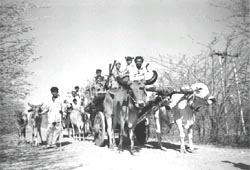Drought of relief
Drought of relief

The 2000 monsoon didn’t keep its date with Dulaiben, 60, resident of Thoridi village in Amreli district of Gujarat. Her eyes stare down the road in the hope of the water tanker that brings 5,000 litres of water for the 600 residents once every week. Her two sons migrated to Ahmedabad in search of jobs a few months ago after it became clear that the 2001 summer was going to be hell due to the second drought year in succession. When the tanker finally appears, a riot breaks out. “Last year I could get a bucket of water every two days, even in May. But, this time around, there has been no water from December. The tanker water causes diseases, but there is no doctor in the village,” she says. The only doctor in the village migrated to Surat in south Gujarat recently due to water scarcity. It isn’t too much better in this region, which is less prone to drought than the Saurashtra and Kutch regions. “The severity of the drought is beyond imagination. It has created a community where everybody fights with each other,” says Mihir Bhatt, director, Disaster Mitigation Institute, Ahmedabad. In early November 2000, Ajitsinh Pachubha Jadeja, in his 20s, was stabbed to death in Dhoraji over a minor dispute over sharing of water.
There are reports of social unrest from all over the state still reeling under the damage caused by the January 26 earthquake. Local government officials and people’s representatives are scared of violent crowds. Big cities and towns like Rajkot and Bhavnagar get water every 20 days and Dhoraji and Upleta get water twice a month. The state’s reservoirs, rivers, and streams have all dried up. The water resources secretariat points out that water storage in different reservoirs of the state was 2 to 12 per cent in September 2000, immediately after the monsoon. At this level, called the dead storage level, no water should have been used. In December the state government allowed this water to be used for drinking after riots broke out for water in several places. In February end, when the state finance minister was in Upleta town near Rajkot to hold a public meeting, he was heckled by 300 women and had to be shifted to safety. In March 2001, 60 per cent of Saurashtra’s 113 minor and major dams had dried and only 20 per cent had dead storage level. On April 7, a 3,000-strong group of women attacked government offices and vehicles in Dhoraji, protesting against the civic body’s inability to supply water in the last one month. By the end of April, almost all dams had dried up, including 20 major ones that supply water to the towns and cities. Government estimates say that at least 11,000 villages need tankers, but only about 250 get this service. “For the rest it is a death wish,” says Digant Ojha, spokesperson for the Citizen’s Initiative, a confederation of civil society groups.
Gujarat is one of the six states facing second consecutive year of drought, and one of the 11 that face a severe drought this summer (see map: Drought 2001: the toll ). About 170 million people in 100,000 villages of India







